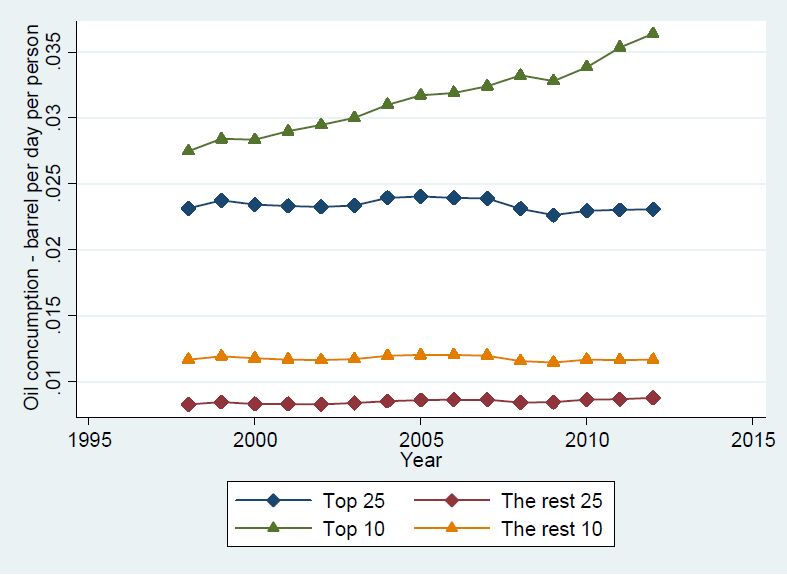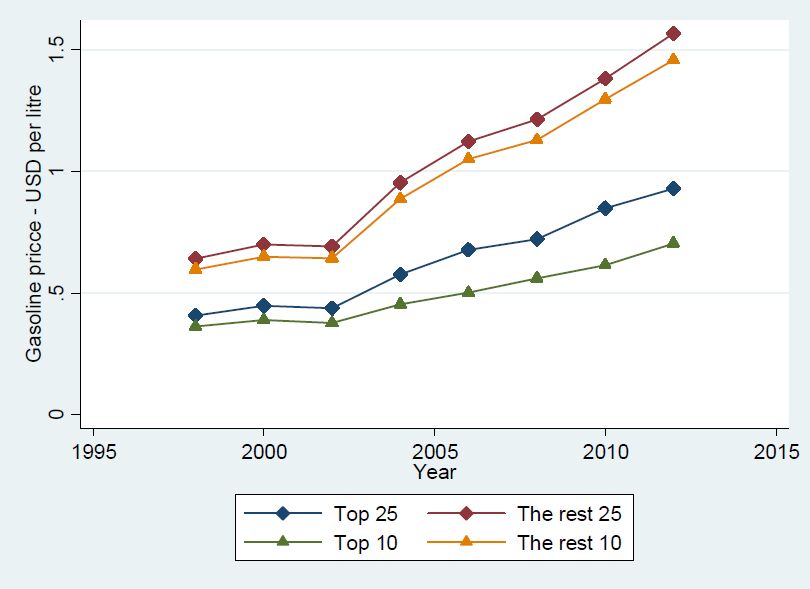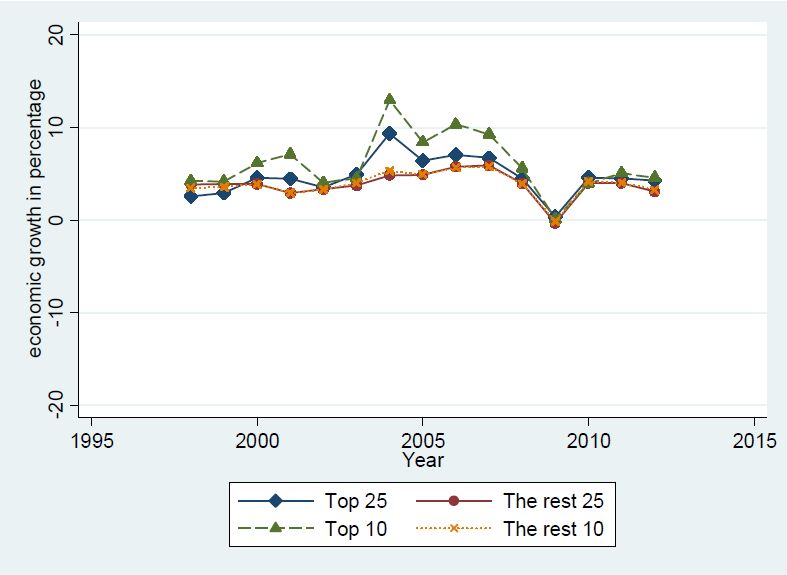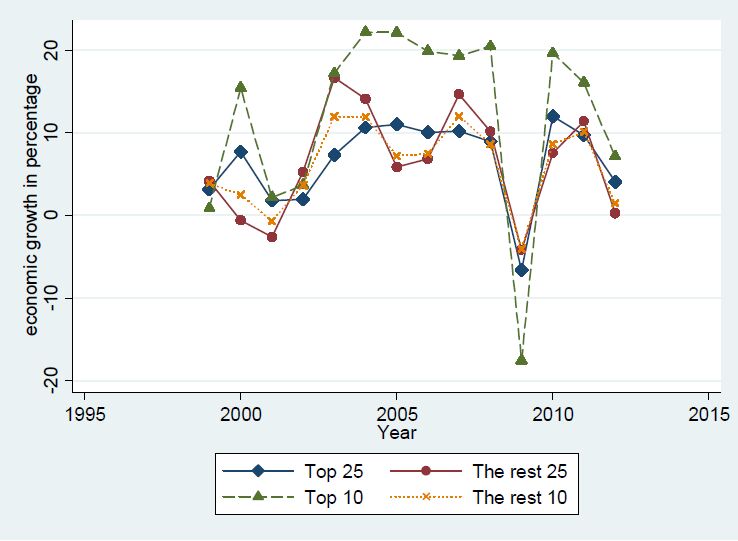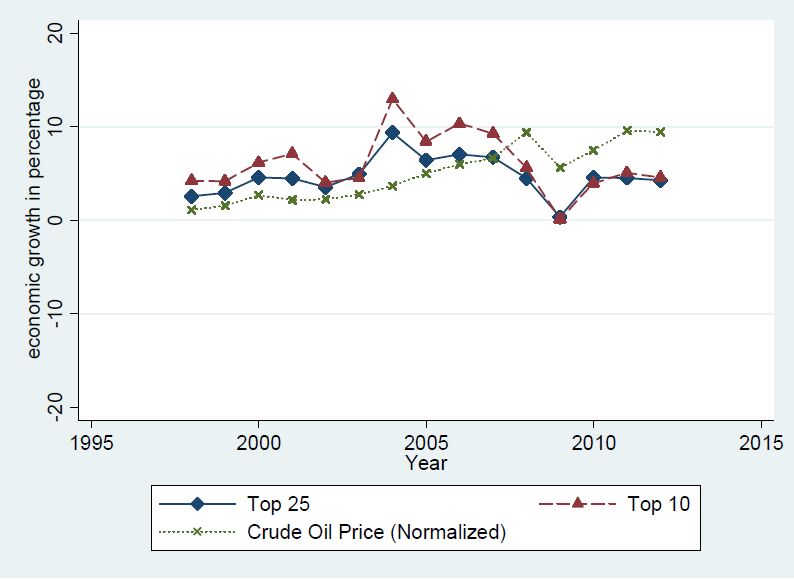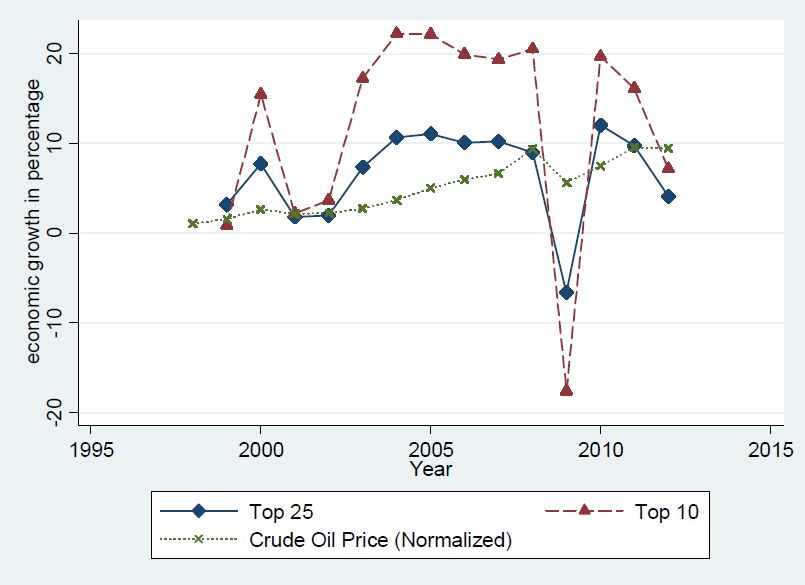1. Introduction
The world’s oil consumption remains one of the main causes of greenhouse gas emissions. It is, therefore, important to learn how to decrease greenhouse gas emissions coming from oil consumption. There are two points of view on this issue: either to improve the technologies used for oil transformation to other sources of energy or to decrease the level of oil consumption and find a replacement with clean and renewable energy. This paper focuses on the second point of view to explore the main determinants of oil consumption. Among others, the determinants of oil consumption are oil price, the level of country industrialization with energy-intensive industry, average temperature, and availability of other possible sources of energy.
According to economics literature, price is an important factor in demand function-the lower the price, the higher the demand and the consumption of the commodity (subject to availability and adequate supply). The important note here is that countries with natural resource endowments in form of production can set a low domestic price for oil and its derivatives. This means that governmental bodies use the “rent” of natural resources to subsidize energy, which provides some degree of political and social popularity for the government.
Another important factor affecting the level of oil consumption is industrialization and economic growth. Many papers in the literature argue that economic growth results in higher energy and oil consumption. As a result, if oil-producing countries experience high economic growth, one cannot argue that a low retail oil price and its derivatives cause high oil consumption in oil- producing countries. In other words, the inference of a causal relationship needs to deliberately control all possible factors. The same holds true for temperature. The average temperature of oil- producing countries and other countries should be similar, which would mean that temperature does not affect energy consumption.
Regarding the role of oil consumption in greenhouse gas emissions, the main goal of this research is to compare oil-producing countries with other countries to determine if there are different levels of oil consumption by a representative individual person. In cases of higher oil consumption in oil-producing countries, this research investigates various possible factors to develop appropriate policies to address related issues. In the remainder of the paper, a review of literature and data analysis are presented to describe oil consumption in different countries. The paper ends with a conclusion and policy implications.
2. Materials and Method
2.1. Literature review
The important question for oil-producing countries is, due to their abundance of oil, whether they have an inappropriate economic performance. In other words, it should be first determined if oil production is a curse or a blessing. Many articles in the literature have maintained that having oil is a curse. The term “natural resource curse” was first introduced by Auty [1]. He argued that there is less incentive for rapid industrial maturation, rent-seeking behaviours are more tolerated, and economic growth is erratic in rich, natural resource producing countries in which longer lax macro policies are tolerated. BrolloNanniciniPerotti et al. [2] also showed that natural resource abundance may increase corruption. RobinsonTorvik and Verdier [3] explained the political foundation of the natural resource curse, which is the tendency of politicians to over-extract natural resources compared with a more efficient method. Such over-extraction may lead to misallocation of resources in the economy and may affect election results.
As a justification for the negative effect of natural resource abundance on economic development, Gylfason [4] mentioned four channels: (a) the Dutch disease, (b) rent seeking, (c) overconfidence, and (d) neglect of education. Roemer [5] conducted a survey and showed that resource-based industrialization does not necessarily result in better national development. According to Stevens and Dietsche [6], there are some policy prescription in terms of institutional change to address the abovementioned issues: (a) capacity building in which well-trained individuals can alter bad situations by practicing good policies, (b) making periodic assessments on how oil exporting countries manage natural resource revenue, and (c) conducting an economic reform process. In terms of economic growth, Sachs and Warner [7] argued that resource-abundant countries are more likely to have a high-price economy. Hence, these countries miss out on export-led growth or other kinds of growth. Additionally, they indicated that such a curse is a reasonably solid fact. However, part of this curse can be explained by adding some omitted geographical or climate variables.
Contrary to the abovementioned evidence supporting the existence of the resource-curse theory without conditions, Brunnschweiler and Bulte [8] argued that “resource abundance” is a proxy for “resource dependence” and resource abundance, constitutions, and institutions determine resource dependence. In addition, although resource dependence does not affect growth, resource abundance positively affects growth. Mikesell [9] asserted that there is nothing inherent in resource abundance that results in low growth or non-sustainability. There are some other economic and political factors discussed in the literature with respect to the positive or neutral effect of natural resources on economic growth and development, which include: (a) corruption, investment, openness, terms of trade, and schooling [10], (b) institutional quality, openness, and initial income [11], (c) institutional quality [12] and [13], (d) institutions and governance [14], (e) political and democracy/dictatorship setting [15], (f) public policy [16], (g) the level that natural resource rent is transformed into capital to improve social welfare [17],(h) government transparency [18], (i) investment, schooling, openness, R&D expenditure, and corruption [19], and (j) the ownership structure of natural resource [20,21].
Oil has been an important source of energy during the past century but it can put a country in a vulnerable situation due to the resource curse. According to Gupta [22], indices such as oil imports to gross domestic product (GDP), oil consumption per unit of GDP, GDP per capita and oil share in total energy supply, and the ratio of domestic reserves to oil consumption can measure oil vulnerability. In addition to putting themselves in a vulnerable situation, the oil-producing countries may also generate some environmental problems affecting other countries (e.g., greenhouse-gas emissions). As Morgan [23] noticed, energy subsidies in developing and oil-producing countries encourage the production and use of fossil fuels that increase greenhouse-gas emissions.
In addition to the notion of resource curse, Friedrichs and Inderwildi [24] have introduced the concept of carbon curse meaning that fossil-fuel rich countries follow more carbon-intensive development trajectories than fossil fuel poor countries. This theory mainly points out that fossil-fuel rich countries have higher consumption for the following reasons: higher CO2 emission due to wasteful practices such as gas flaring, easy access to domestic fuel in such countries, less incentive for energy efficiency, and uneconomic fuel consumption subsidies.
The important question here is whether oil-producing countries generally consume more oil than other countries. If this is the case, then verification should be made to determine if over- consumption is a necessity for economic growth and development or if it is the result of low energy prices/inefficient energy consumption. In other words, if the oil-producing countries generally experience low economic growth then it is not possible to interpret economic growth as a push for energy consumption and the reasons for energy consumption should be found in price, subsidies, or other reasons. Before analysing the data, articles investigating the correlation between economic growth and energy consumption as well as those exploring energy subsidy and price are reviewed.
Numerous studies investigated the correlation between energy consumption and economic growth, most of which showed a positive correlation. Such a correlation has been proven for 18 developing countries 1 [25], including some Sub-Sahara African countries 2 [26]. The causal relationship from energy consumption to GDP and economic growth has also been also verified in the cases of Argentina, Italy, Korea, Turkey, France, Germany, Japan [27], Iceland, Italy, the Slovak Republic, the Czech Republic, Korea, Portugal, the U.K. [28], Indonesia, Iran, Nigeria, Qatar, Venezuela [29], and Greece [30]. Moreover, for the oil-exporting countries, Mehrara [31] showed a strong causality from economic growth to energy consumption. (1 The countries are South Korea, Singapore, Hungary, Argentina, Chile, Colombia, Mexico, Peru, Venezuela, Indonesia, Malaysia, Philippines, Thailand, India, Pakistan, Sri Lanka, Ghana, Kenya. 2 The countries are Cameroon, Cote D'Ivoire, Gambia, Ghana, Senegal, Sudan and Zimbabwe. 3 The countries are Armenia, Azerbaijan, Belarus, Estonia, Georgia, Kazakhstan, Kyrgyzstan, Latvia, Lithuania, Moldova, Russia, Tajikistan, Turkmenistan, Ukraine, and Uzbekistan.)
In a general argument, Lee and Chang [32] stated that there is bi-directional causality between energy consumption and economic growth in developed countries. Apergis and Payne [33] considered 11 countries of the Commonwealth of Independent States and indicated that energy consumption causes economic growth in the short run but bi-directional causality exists in the long run. The bi-directional causality between renewable energy consumption and economic growth for both short-run and long-run analyses was verified for 13 countries 3 within Eurasia [34], in Korea [35], and in Malaysia and Singapore [36]. According to Wolde-Rufael [37], the results for direction of causality are mixed and the author comes to the same conclusion for 19 African states by showing (1) causality from economic growth to energy consumption in some countries, (2) reverse causality for most of the countries, and (3) the lack of a causal relationship for the rest.
Although literature has rarely shown a negative relationship between energy use and economic growth [38], it is possible to argue that there is at least a correlation (and causality in some cases) between energy consumption and economic growth. Assuming this argument, the high- energy consumption of countries with low economic growth cannot be justified by economic growth and its causes should be found in other factors. The temperature [39,40,41,42] and price of energy carriers are two other determinants of energy consumption discussed in the literature. Some of the empirical evidence in regard to the effect of price and energy subsidy are reviewed in the following section.
Oil and its derivatives are supplied with subsidies (low prices) in most of the oil-producing countries and oil is used in an inefficient way compared with other countries. For instance, GuptaClementsFletcher et al. [43] showed that major oil-exporting countries are net subsidizers of petroleum while oil-importing countries are net taxers. The results also revealed that implicit subsidies of oil-exporting countries are 3.5% of GDP and 15.2% of government expenditures while price reform is the best solution for such issues. KarbassiAbduli and Mahin Abdollahzadeh [44] demonstrated that the pattern of Iran’s energy consumption is unsustainable and suggested that price reform can modify the energy consumption. In the case of Saudi Arabia, Alyousef and Stevens [45] referred to the huge subsidy for domestic energy consumption, which is caused by a low price regime. In another study, GatelyAl-Yousef and Al-Sheikh [46] showed that Saudi Arabia experienced a nine-fold increase of oil consumption in 40 years-to nearly one-fourth of production-while income growth is less than energy consumption growth that challenges Saudi Arabia’s capacity to export. They also showed the quick growth of OPEC′s domestic oil consumption.
Nonetheless, Narayan and Smyth [47] showed that although oil demand in the Middle East (as the market with a low retail price in general) depends on price, it is highly price inelastic and slightly income elastic. This can be justified with the notion of the natural resource curse in which the Middle Eastern countries are net exporter of natural resource (mainly oil and gas) with high income and consumers are rich and insensitive to the price. In another study on the same region, Fattouh and El- Katiri [48] investigated the Middle East and North African countries where energy subsidies result in misallocation of resources. The authors suggested that there is a need for energy-pricing reform. Askari and Jaber [49] explained that the oil-exporting countries in the Persian Gulf do not implement appropriate policies for their oil revenue.
2.2. Data and methodology
The data set includes information on oil supply, domestic consumption, retail price, population, and economic growth from 1998-2012, as well as the average temperature for the time period of 1961-1990 [50]. The oil supply, domestic consumption, and country population are gathered from the U.S. Energy Information Administration website. Oil supply and consumption are reported in the form of thousand barrels per day and population is reported in the form of million people. The following variables are also downloaded from the World Bank website: (1) the retail price for gasoline (converted from the local currency to U.S. dollars), which refers to pump prices of the most widely sold grade of gasoline; (2) annual percentage of GDP growth based on constant local currency, which is deflated by constant 2005 U.S. dollars (the GDP is calculated by aggregating the gross added value of all individuals in the economy plus any product taxes and minus any subsidies not included in the value of the products); and (3) average temperature for the time period of 1961-1990 [51].
To demonstrate that oil-producing countries are among the countries with high oil consumption, the following steps are followed. First, the countries are sorted and grouped according to the amount of oil production. One categorization is to compare the top 10% with other countries and another option is to compare the 25% countries and the others (the list of top 10% and top 25% countries and the average of their variables are reported in Table 1). Second, the oil consumption trends of the top 10% and the top 25% countries in terms of oil production are compared to the consumption trends of other countries. Third, the same comparisons are done for economic growth, gasoline retail prices, and average temperatures between top oil producers and other countries to determine if there are differences in peripheral, institutional, or economic conditions. Such comparisons make it possible to argue which variable(s) does or does not cause high oil consumption. Policy suggestions can then be made after making these arguments available.
Table 1. A List of the Top 10% and the Top 25% Countries in Terms of Oil Production and their Average Oil Supply, Oil Consumption, Economic Growth, Gasoline Retail Price, Temperature (time period 1998-2012).
| Country |
Top 10% of oil producing countries |
Top 25% of oil producing countries |
Oil supply (Barrel per day per person) |
Oil consumption (Barrel per day per person) |
Economic growth |
Gasoline retail price (US dollar per liter) |
Temperature (Celsius) |
| Algeria |
|
+ |
0.053 |
0.008 |
3.761 |
0.299 |
22.5 |
| Angola |
+ |
+ |
0.089 |
0.004 |
9.280 |
0.446 |
21.5 |
| Argentina |
|
+ |
0.021 |
0.014 |
3.738 |
0.886 |
14.8 |
| Australia |
|
+ |
0.031 |
0.049 |
3.320 |
0.839 |
21.6 |
| Azerbaijan |
+ |
+ |
0.067 |
0.012 |
12.243 |
0.543 |
11.9 |
| Bahrain |
|
+ |
0.054 |
0.038 |
4.910 |
0.246 |
27.1 |
| Belize |
|
+ |
0.006 |
0.018 |
4.947 |
1.148 |
25.3 |
| Bolivia |
|
+ |
0.006 |
0.006 |
3.786 |
0.648 |
21.5 |
| Brazil |
|
+ |
0.011 |
0.012 |
2.974 |
1.075 |
24.9 |
| Canada |
+ |
+ |
0.098 |
0.067 |
2.532 |
0.789 |
-5.4 |
| Chad |
|
+ |
0.009 |
0.000 |
8.329 |
1.028 |
26.5 |
| Colombia |
|
+ |
0.016 |
0.007 |
3.503 |
0.825 |
24.5 |
| Croatia |
|
+ |
0.006 |
0.021 |
1.855 |
1.191 |
10.9 |
| Denmark |
|
+ |
0.058 |
0.035 |
1.012 |
1.475 |
7.5 |
| Ecuador |
|
+ |
0.034 |
0.013 |
3.559 |
0.484 |
21.8 |
| Egypt |
|
+ |
0.010 |
0.009 |
4.538 |
0.343 |
22.1 |
| Equatorial Guiney |
+ |
+ |
0.477 |
0.004 |
16.445 |
. |
24.5 |
| Estonia |
|
+ |
0.005 |
0.019 |
4.496 |
1.035 |
5.1 |
| Gabon |
+ |
+ |
0.191 |
0.010 |
1.707 |
0.796 |
25 |
| Indonesia |
|
+ |
0.005 |
0.005 |
3.844 |
0.400 |
25.8 |
| Iran |
|
+ |
0.054 |
0.021 |
4.204 |
0.113 |
17.2 |
| Iraq |
+ |
+ |
0.087 |
0.021 |
5.879 |
0.780 |
21.4 |
| Kazakhstan |
+ |
+ |
0.073 |
0.013 |
7.093 |
0.598 |
6.4 |
| Kuwait |
+ |
+ |
1.081 |
0.140 |
4.499 |
0.218 |
25.3 |
| Libya |
+ |
+ |
0.279 |
0.042 |
4.320 |
0.151 |
21.8 |
| Malaysia |
|
+ |
0.029 |
0.021 |
4.323 |
0.444 |
25.4 |
| Mexico |
|
+ |
0.032 |
0.020 |
2.575 |
0.666 |
21 |
| New Zealand |
|
+ |
0.011 |
0.036 |
2.619 |
0.969 |
10.5 |
| Nigeria |
|
+ |
0.016 |
0.002 |
7.448 |
0.394 |
26.8 |
| Norway |
+ |
+ |
0.612 |
0.049 |
1.806 |
1.665 |
1.5 |
| Oman |
+ |
+ |
0.314 |
0.031 |
4.464 |
0.310 |
25.6 |
| Papua New Guinea |
|
+ |
0.009 |
0.004 |
3.385 |
0.705 |
25.2 |
| Qatar |
+ |
+ |
1.156 |
0.090 |
12.624 |
0.207 |
27.1 |
| Romania |
|
+ |
0.006 |
0.010 |
2.877 |
1.015 |
8.8 |
| Russia |
+ |
+ |
0.061 |
0.019 |
4.542 |
0.625 |
-5.1 |
| Saudi Arabia |
+ |
+ |
0.433 |
0.084 |
4.983 |
0.190 |
24.6 |
| Sudan and South |
|
+ |
0.008 |
0.002 |
. |
. |
26.8 |
| Suriname |
|
+ |
0.023 |
0.024 |
3.921 |
0.843 |
25.7 |
| Syria |
|
+ |
0.024 |
0.014 |
4.103 |
0.635 |
17.7 |
| Thailand |
|
+ |
0.005 |
0.013 |
3.262 |
0.766 |
26.3 |
| Timor-Leste |
+ |
+ |
0.075 |
0.001 |
. |
. |
. |
| Trinidad and Tobago |
+ |
+ |
0.119 |
0.027 |
5.075 |
0.387 |
25.7 |
| Tunisia |
|
+ |
0.008 |
0.009 |
4.127 |
0.715 |
19.1 |
| Turkmenistan |
|
+ |
0.040 |
0.019 |
8.854 |
0.104 |
15.1 |
| United Arab Emirates |
+ |
+ |
0.678 |
0.109 |
4.162 |
0.351 |
27 |
| United States |
|
+ |
0.031 |
0.067 |
2.303 |
0.581 |
8.5 |
| Uzbekistan |
|
+ |
0.005 |
0.005 |
6.560 |
0.640 |
12.1 |
| Venezuela |
+ |
+ |
0.112 |
0.025 |
2.828 |
0.056 |
25.3 |
|
|
|
|
|
|
|
|
| Total |
|
|
0.140 |
0.046 |
4.746 |
0.631 |
19.348 |
The natural resource production is normalized by the number of population. To have a more significant analysis, the data is provided in the form of per-capita oil consumption and per-capita oil production instead of total production and consumption. In such an analysis, every country would have a representative individual that is comparable to those of other countries. The other related variables are also assigned to these representatives (economic growth as an increase in income, gasoline retail price as an indicator for decision making on oil consumption, and temperature as another determinant of energy consumption).
The proposed methodology is similar to experiment designs used in empirical scientific studies, in which the effect of manipulation is measured in one experiment while the control group has no manipulation. The current paper aims to construct two average individuals, one represents the countries with high oil production (the top 25% and 10%) while the second represents other countries. Comparing the characteristics of average individuals, it is possible to find an effect of one factor on oil consumption if the other factors are similar to each other for both groups. This methodology seeks to show that the reason behind oil over-consumption in oil-exporting countries is due to the low price of oil derivatives while the other factors, including temperature and economic growth, remain very similar in both groups.
Two points should be mentioned about the construction of oil consumption per capita and the average economic growth for the group of countries. In the former and to have a proper average, the consumptions of all countries in the group are aggregated and then divided by the total population of the group to have a per capita consumption of the group. In order to determine the average economic growth for a group of countries, two possibilities exist and this article tests both: (1) growth index 1, in which the simple average of economic growth between the different countries is made; and (2) growth index 2, in which the aggregate GDP is constructed and economic growth is made based on the annual difference of the aggregate GDP.
3. Results and Discussion
In the following graphs, a comparison is made between the countries that are top oil producers per capita (group A-listed in Table 1) and other countries (group B). First, graph 1 shows that group A has higher oil consumption. This graph also shows that the top 10% has even more oil consumption than the top 25%. Moreover, the top 10% countries in terms of oil production are the only ones that experience a rising consumption trend. This would indicate other countries, that are generally net importer of oil, probably use alternative energy sources either in form of natural gas or renewable sources (solar and wind power). Regarding the literature, the high-energy consumption of natural resource-producing countries can be a symptom of the resource curse, or a sign of resource misallocation or institutional under-development. To call such high oil consumption a curse for these countries, other factors such as economic growth and retail price should also be checked. These factors are important determinants of energy consumption and their effects are independent from the resource curse.
Second, graph 2 indicates that group A has a lower price of gasoline at the pump as representative of oil retail prices. After 2002, the price has shown an increasing trend for both groups. However, group B has experienced quite a sharper trend, which means that the price difference between the two groups becomes greater over time in favour of access to cheaper oil derivatives for group A. It is noteworthy that gasoline retail prices have been converted from the local currency to U.S. dollars for each year and each country, meaning that all gasoline prices are reported in one currency and as a result can be compared while the fluctuation of the exchange rate has been controlled. The lower the price, the more incentive individuals have to consume more gasoline (as a product of crude oil) or to substitute another energy carrier by any of the oil derivatives.
Third, the graphs 3 and 4 show that group A has a slightly higher economic growth especially after the crude oil price rise in 2002, which increased public revenue as a potential for new development. According to the literature, high-energy consumption can cause economic growth and vice versa. However, considering the fact that the oil consumption of group A is always higher than group B, it is very hard to conclude that outperformance of group A in terms of economic growth between 2002 and 2008 is due to oil consumption or that it causes high oil consumption. Optimistically speaking, it is only possible to argue that in a short period of time, the correlation between high-energy consumption and economic growth exists but is not always true. The difference between graphs 3 and 4 is the way in which average economic growth is defined. In Figure 3,average growth is calculated based on the average of economic growth in different countries but in Figure 4,average growth is defined as the growth in the aggregated GDP of countries. The growth variable in Figure 3 is constructed based on simple average of economic growth over the years but the point is that the economic growth of a big economy (an economy with high GDP) has more of an effect on aggregate GDP. To consider the effect of different countries, growth variable in Figure 4 is constructed in a way to measure the growth of aggregate GDP of countries.
Although in some periods of time, oil exporting countries have higher economic growth, figures 5 and 6 show that this difference can be explained by oil price (Economic growth is calculated similar to figures 3 and 4). The figures show that boom/bust cycles are correlated with oil price, and it is not an economic growth necessarily because of development and institutional change. This would be consistent with Allcott and Keniston [52], in which the authors argue that manufacturing sector is pro-cyclical with resource booms, originated by the growth in upstream parts.
Finally, Table 2 shows that the average temperature of group A and B are the same. Therefore, temperature is not a cause for a difference in oil consumption. Making argument based on the average temperature may be simplistic interpretation but it just provides a sense to show indifferent effect of temperature on energy consumption.
Table 2. A Comparison Between the Average Temperature of Top Oil-Producing Countries and Other Countries.
| Group description |
Average temperature (Celsius degree) |
| Top 10% |
18.7 |
| Top 25% |
19.3 |
| Below 75% |
18.5 |
| Below 90% |
18.7 |
Regarding the three above graphs and Table 1, the main element causing higher oil consumption in oil- rich countries is the low price of oil derivatives such as gasoline compared with countries in group B. This means that the representative individuals in group A receive a price signal to consume more oil. The interpretation of this finding is to show the benefits of retail price reform, which is supposed to result in less oil consumption and less damage to the environment due to less greenhouse gas emissions. No conclusion can be drawn about consumption efficiency and the existence of other possible energy sources, which directly affect individuals’ utility from the difference in oil consumption between group A and group B.
The individual’s utility in terms of energy consumption is a function of different variables. For instance, in more developed countries, renewable energy plays an important role in terms of energy supply or the buildings are insulated with modern and up-to-date technologies. These two examples are variable in different countries. Therefore, the level of correlation between utility gained from energy consumption and the amount of oil consumption are different because the sources of energy and percentage waste are different. In the other words, it is not possible to conclude that representative individuals of the countries in Table 1 have the same energy utility if they have the same oil consumption. With the same reasoning, it is also not possible to conclude that the energy utility is higher for individuals in group A.
4. Conclusion and Policy Implications
The results show that oil-producing countries have significantly higher oil-consumption levels than other countries. To control for the effects of population, this paper conducts a per-capita analysis in which the oil-producing countries are identified based on per-capita oil production and oil consumption is also assessed based on per-capita consumption. Addressing the debate in literature, this paper argues that among possible causes for higher energy consumption, there may be two main reasons: a low energy retail price compared with other countries or higher economic growth, which needs more energy to build up new infrastructure and to expand the economy.
Reviewing the trend of average oil retail prices and average economic growth for the top 25% and top 10% of oil-producing countries, the data shows that oil-producing countries have low prices and relatively the same economic growth compared with the other countries. The top oil-producing countries have higher economic growth for some years but its growth trend is correlated with crude oil price. In other words, such high growth does not necessarily imply institutional change. It is possible to argue that the main cause of high oil consumption is the low price. In addition, it should be noted that the global environmental movement against increasing greenhouse gas emissions- such as the Kyoto protocol in 1998, for example-seems to have had no effect on oil consumption.
This research could propose two policy implications. Some articles such as Pineau [53] have discussed that selling energy for a low price or subsidizing energy does not necessarily generate a socially optimum situation. According to the results of this paper, the first policy advice is to deregulate the market and let players buy and sell oil products in a free market. At the same time, there is an option for the government to compensate individuals with direct payments. It is expected that even after such monetary compensation, a net benefit would remain consisting of less energy consumption and a net profit due to the price increase. The second implication is a suggestion to world organizations such as the United Nations (U.N.), which has the power of enforcement, to carefully watch the amount of greenhouse gas emissions produced by oil-producing countries. Such organizations should set some relevant policies by which oil-producing countries have no incentives to consume oil more than other countries.
Conflict of Interest
All authors declare no conflicts of interest in this paper.









 DownLoad:
DownLoad: 